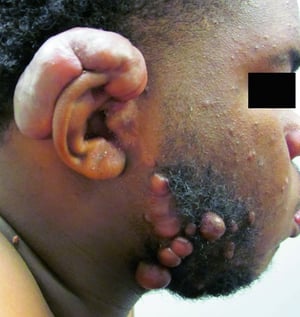Keloids are smooth overgrowths of fibroblastic tissue that arise in an area of injury (eg, lacerations, surgical scars, truncal acne) or, occasionally, spontaneously.
Topic Resources
Keloids are more frequent in dark-skinned patients. They tend to appear on the upper trunk, especially the upper back and mid chest, and on deltoid areas. Unlike hypertrophic scars, keloidal scar tissue extends beyond the margins of the wound or injury. They may appear spontaneously.
This photo shows keloids on the ear and beard area after dog-bite injuries.
© Springer Science+Business Media
A keloid is hypertrophied tissue that develops in an area of injury or spontaneously; keloids are shiny, smooth, often dome-shaped, and slightly pink or hyperpigmented.
Image provided by Thomas Habif, MD.
In distinction from hypertrophic scars, keloids extend beyond the borders of the original wound invading normal skin. The patient has multiple large keloid scars on the anterior abdominal wall, after intra-abdominal surgery.
© Springer Science+Business Media
Keloids are shiny, firm, smooth, usually ovoid but sometimes contracted or webbed, and slightly pink or hyperpigmented.
Diagnosis of Keloids
Clinical evaluation
Diagnosis of keloids is clinical.
Treatment of Keloids
Possibly corticosteroid injection, excision, gel sheeting, and/or immunomodulators
Treatment of keloids is often ineffective.
Monthly corticosteroid injections (eg, triamcinolone acetonide 5 to 40 mg/mL) into the lesion sometimes flatten the keloid. Monthly corticosteroid injections (eg, triamcinolone acetonide 5 to 40 mg/mL) into the lesion sometimes flatten the keloid.
Surgical or laser excision may debulk lesions, but they usually recur larger than before. Excision is more successful if preceded and followed by a series of intralesional corticosteroid injections. Gel sheeting (applying a soft, semiocclusive dressing made of cross-linked polymethylsiloxane polymer, or silicone) or pressure garments are other adjuncts to prevent recurrence.
More recently, immunomodulators (eg, topical imiquimod) have been used to prevent keloid development or recurrence.More recently, immunomodulators (eg, topical imiquimod) have been used to prevent keloid development or recurrence.




